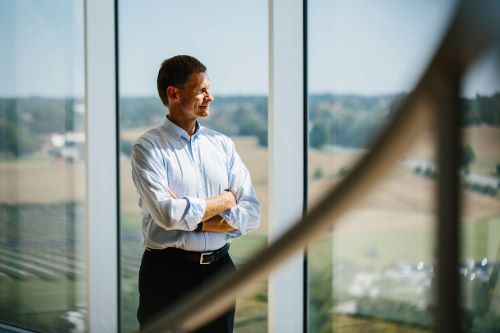Using energy at the right time can save 40 million tons of CO2 emissions annually

A new analysis commissioned by Danfoss reveals that an ambitious but realistic roll out of demand-side flexibility technology in the EU and UK can save 40 million tons of CO2 emissions each year by 2030, more than Denmark’s domestic climate footprint. Additionally, the EU and UK can achieve an annual societal cost savings of €10.5 billion by 2030 and €15.5 billion by 2050. These savings already account for the majority of implementation cost of demand-side flexibility infrastructure.
During the recent energy crisis, EU countries earmarked €681 billion and the UK £90 billion (€103 billion) in response. Rolling out demand-side flexibility technologies can make the grid more resilient and reduce the need for government subsidies at this scale. It also has vast potential to save money at both a societal and consumer level. Across the EU and UK, the average consumer could save 7% on their electricity bill by 2030 and 10% by 2050.
Kim Fausing, President and CEO, Danfoss says: “We are leaving the fossil fuel era, but we haven’t prepared our energy system for the future because we are neglecting energy efficiency as one of the main tools to lower emissions. The grid is not ready to use all the renewable energy we are making rapid progress to produce. We must take steps to utilize energy efficiency solutions – such as demand-side flexibility technologies – that not only help us to use less energy, but to use the right energy at the right time. We have the solutions, but we need action.”
Demand-side flexibility refers to the levelling out of energy consumption to prevent periods of simultaneous high demand and low supply, which is especially important for an energy system based on renewables. The deployment of demand-side flexibility technologies can lower demand during expensive peak hours and reduce the amount of fossil fuels in the energy mix.
In buildings, for example, AI-driven technologies can save up to 20% in a building’s energy costs by combining building, weather, and user data to predict heating and ventilation demand.[i] Observations on 100,000 flats equipped with this technology, based mainly in Finland, show that the maximum power usage was reduced by 10-30%.[ii]Meanwhile, load-shifting can also be automated to cool supermarket freezers down to a much lower temperature than required outside the peak demand hours with the freezers effectively operating like a battery storing energy. This ‘supercooling’ technique means refrigerators can be switched off during the peak hours of energy demand, both lowering stress on the grid and saving money for the supermarket.
Renewables need to make up 70% of the energy mix by 2050 if the goals of the Paris Agreement are to be reached. However, the energy system is not yet prepared to manage the natural peaks and troughs of renewable energy supply.
In the Middle East, oil-producing countries are actively pursuing sustainability in response to mounting global concerns about climate change. The Gulf Cooperation Council (GCC) countries, in addition to their Paris Agreement commitments, are focusing on carbon reduction initiatives and the expansion of sustainable energy practices. Saudi Arabia’s Vision 2030 targets a Net Zero future by 2060, with a strong commitment to clean energy, aiming to derive 50% of their energy from renewables by 2030. Similarly, the UAE government has approved a national hydrogen strategy to become a major green hydrogen producer, with plans for substantial production and emissions reduction across sectors as part of their broader energy plans.
Ziad Al Bawaliz, the Regional President at Danfoss Turkey, Middle East, and Africa, highlighted the GCC’s significant role in promoting a greener global climate. He stated, “We are witnessing a strong commitment from GCC countries to embrace sustainable practices in alignment with their Paris Agreement commitments. The UAE, hosting COP28 at the end of this month, exemplifies the country’s dedication to addressing the escalating climate emergency. In parallel with expanding renewable energy use, it is essential that we must prioritize investments in energy efficiency solutions.”
The new whitepaper from Danfoss, “Energy Efficiency 2.0: Engineering the Future Energy System”, presents the most cost-efficient way to prepare for the future energy system. It focuses on the deployment of a full-scale electrification of society, demand-side flexibility measures, wise use of hydrogen and storage and maximizing the use of excess heat.
Key whitepaper takeaways:
- By transitioning from a fossil energy system to a fully electrified one, it is possible to cut up to 40% of final energy consumption. Electrification is itself a form of energy efficiency.
- Through demand-side flexibility, the EU and UK can annually save 40 million tons of CO2 emissions and achieve annual societal cost savings of €10.5 billion by 2030. Similarly, households can save on average 7% on their electricity bills. In 2050, households are estimated to save 10% on electricity bills and €15.5 billion annual societal costs.
- In the US, optimizing efficiency, demand flexibility, and electrification in buildings can save up to $107 billion in annual power system cost savings alongside a 91% reduction in carbon emissions from buildings by 2050.
- In 2030, up to 53% of the global energy input will be wasted as excess heat. However, much of this heat can be captured and reused to heat buildings and water through deeper sector integration.
- On a global scale it is theoretically possible by 2050 to recover 1.228 TWh of excess heat from hydrogen produced through electrolysis – this is equivalent to almost two thirds of today’s global heat generation from coal, the largest source of heat.
- In the EU, about 83 of TWh excess heat can theoretically be recovered from electrolysis already by 2030, enough to cover Germany’s current domestic heating more than 1.5 times.
Kim Fausing adds: “Electrification, demand-side flexibility, conversion, storage, and sector integration must take center stage in a future energy system enabling an energy grid powered by renewables. Seeing is believing, and, often, decision makers simply don’t know that we already have the solutions we need to not only reduce carbon emissions, but also to deliver substantial economic savings both at a societal and customer level. It’s about time for decision makers at all levels to prioritize energy efficiency and set the right regulatory and economic framework to reach net zero by 2050.”
Professor Nick Eyre, Professor of Energy and Climate Policy at University of Oxford & Senior Research Fellow in Energy at the Environmental Change Institute, says: “We need to rethink energy efficiency and place it at the center of the race towards full decarbonization. This means enabling the electrification of end-uses not previously served by electricity. It also means creating a highly flexible energy system to avoid carbon-intensive demand peaks. Historically, energy efficiency has delivered the largest share of greenhouse gas mitigation and reinventing it for the era of renewables will enable us to continue this trend and achieve net zero by 2050.”
Toby Morgan, Senior Manager, Built Environment at Climate Group, says: “As we electrify everything we can and build a flexible grid fit for the future, we cannot forget energy efficiency. The greenest form of energy is saving energy, and efficiency means we need fewer wind farms and fewer battery facilities. AI can help turbocharge progress on energy efficiency, optimising electricity usage for any given time of day. Yet AI’s role in connecting up climate-smart technologies in one integrated, energy efficient building is where it gets really exciting. AI can optimise the use of rooftop solar when it’s sunny, make decisions on when to draw on the building’s battery storage, or the batteries of EVs plugged into its charging points when it’s not, plus choose an optimum time to sell renewable electricity back to the grid when demand is high.”
Last Updated on 1 year by News Desk 1












